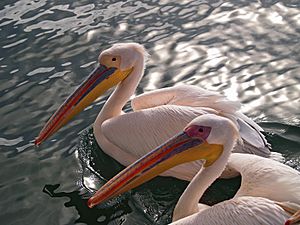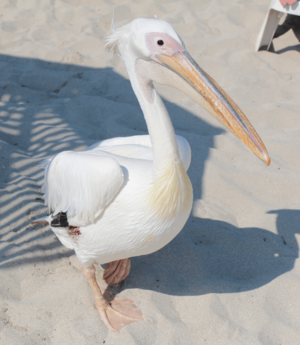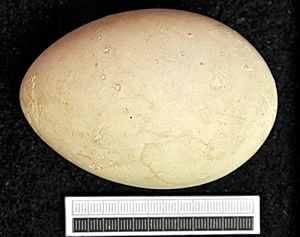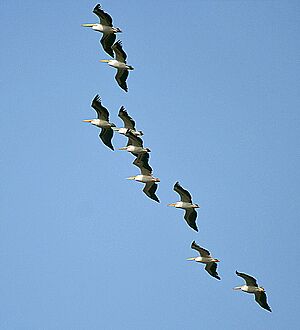Great white pelican facts for kids
Quick facts for kids Great white pelican |
|
|---|---|
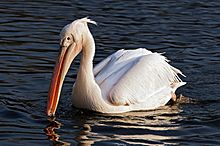 |
|
| Great white pelican | |
| Conservation status | |
| Scientific classification | |
| Kingdom: | |
| Class: | |
| Order: | |
| Family: | |
| Genus: |
Pelecanus
|
| Binomial name | |
| Pelecanus onocrotalus (Linnaeus, 1758)
|
|
The great white pelican (Pelecanus onocrotalus) is also known as the Eastern white pelican or white pelican. These amazing birds are the second largest in the pelican family. Only the Dalmatian pelican is bigger than them.
Great white pelicans live and have their babies in southeastern Europe, south Asia, and Africa. Most of them, about 80% of the 90,000 breeding pairs, live in Africa. Sadly, because of changes to their homes and the climate, some groups of great white pelicans are becoming smaller.
Contents
What Does a Great White Pelican Look Like?
The Great White Pelican is a very large bird. It can weigh about 10 kilograms (22 pounds) and be 160 centimeters (63 inches) long. Its wings can spread out to 280 centimeters (110 inches) wide!
You can tell it apart from the Dalmatian pelican because it has pure white feathers, not grayish-white ones. It also has a pink patch of skin around its eye and pinkish legs. Male pelicans are larger than females. Males have a long beak that curves downwards, while females have a shorter, straighter beak. Young pelicans are gray and have dark feathers for flying.
When flying, these pelicans look very graceful. They often soar high in the sky with their heads held close to their bodies. When it's time to breed, the male's face skin turns pink, and the female's turns orangey.
How Do Great White Pelicans Live?
Great white pelicans are perfect for living in water. Their short, strong legs and webbed feet help them swim and push off the water to fly. Once they are in the air, these long-winged birds are strong flyers. They often fly together in cool V-shapes.
A pelican's large pouch under its beak is like a big scoop. When the pelican puts its beak underwater, the lower part bows out, making a huge pouch that fills with water and fish. As the bird lifts its head, the pouch squeezes the water out, but the fish stay inside.
Sometimes, a group of 6 to 8 great white pelicans will work together to catch fish. They form a horseshoe shape in the water and dip their beaks at the same time. This creates a circle of open pouches, ready to catch all the fish nearby!
Where Do Great White Pelicans Live?
You can find groups of great white pelicans spread out from the eastern Mediterranean Sea all the way to Vietnam and south to South Africa. Some groups stay in Africa all year round, especially south of the Sahara Desert. They live mostly in areas near the coast, river mouths, and around very big lakes.
Other groups of pelicans travel a lot. They live in Eastern Europe to Kazakhstan during the breeding season. In winter, they fly to northeast Africa, through Iraq, and to north India. More than half of all Great White Pelicans have their babies in the Danube Delta in Romania.
What Do Great White Pelicans Eat?
The main food for Great White Pelicans is fish. Each pelican needs to eat about 1.4 kilograms (3 pounds) of fish every day. That's a lot of fish! For example, the largest group of Great White Pelicans, at Tanzania's Lake Rukwa, eats about 28 million kilograms of fish each year!
Pelicans are not picky eaters, though. They will eat other things if they get the chance. Sometimes, they even eat baby birds of other species. For instance, off the coast of South Africa, pelicans have been seen eating young Cape Gannets. Great White Pelicans also eat crabs and shrimp, tadpoles, and even small turtles. They are happy to take food from humans, and some unusual items have been found in their diet. If they are very hungry, pelicans might even eat seagulls and ducklings. They hold the seagulls underwater until they drown, then eat them headfirst. Pelicans will also try to steal food from other birds.
Great White Pelican Life Cycle and Reproduction
The breeding season for pelicans starts in April or May in cooler places. In Africa, they can breed all year round, and in India, it's from February to April. Many pelicans gather together to have their babies in large groups called colonies.
A female pelican usually lays 1 to 4 eggs, but two eggs are most common. Where they build their nests can be different. Some groups build stick nests in trees. But most, especially those in Africa, make their nests on the ground. They scratch a shallow hole and line it with grass, sticks, feathers, and other materials. Both parents take care of the young.
The eggs hatch after about 29 to 36 days. When the chicks hatch, they are naked, but they quickly grow fuzzy, dark brown feathers. About 20 to 25 days after hatching, the young chicks gather in groups called "pods." They learn to fly when they are about 65 to 75 days old. About 64% of young pelicans make it to adulthood. They can start having their own babies when they are 3 to 4 years old.
Adult pelicans are usually safe from birds of prey because they are so big. However, eagles, especially sea eagles, might eat their eggs, baby birds, or young birds that are just learning to fly. Sometimes, mammals like jackals or even lions attack pelicans and their young at their colonies. If a large animal or human gets too close, pelicans might leave their nests to protect themselves. Also, crocodiles, especially Nile crocodiles in Africa, will sometimes catch and eat pelicans swimming in the water.
Pelicans and People
Today, in some places, there aren't enough fish because of overfishing. This means Great White Pelicans have to fly long distances to find food. People use great white pelicans for different things. Their pouch can be used to make bags, and their skin can be made into leather. Their droppings, called guano, are used as fertilizer. The fat from young pelicans is even used to make oils for traditional medicine in China and India.
Human activities, like disturbing their homes, losing places to find food and have babies, and pollution, are all causing the number of Great White Pelicans to go down.
These birds are often kept in zoos or in special semi-wild groups. For example, there's a famous group in St. James's Park, London. The first pelicans in this park were given to King Charles II by the Russian Ambassador in 1664. This started a tradition where ambassadors would give these birds as gifts.
Images for kids
-
in Ethiopia
-
in Ethiopia
-
In Bangladesh
-
Two white pelicans flying in formation (Botswana).
-
Pelican taking off from the water in the Danube Delta, Romania
See also
 In Spanish: Pelícano común para niños
In Spanish: Pelícano común para niños



